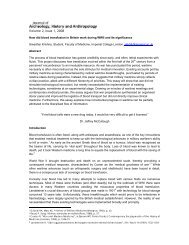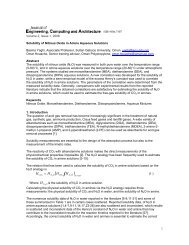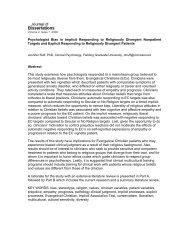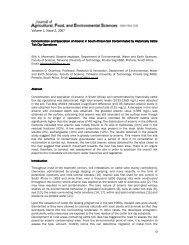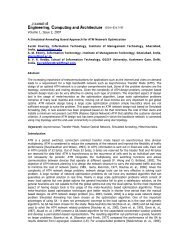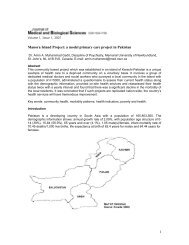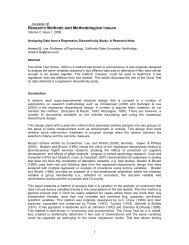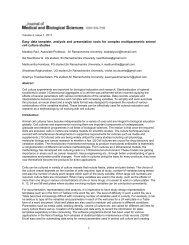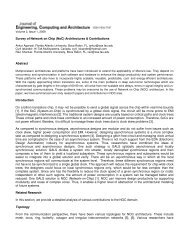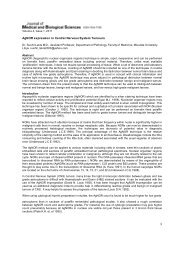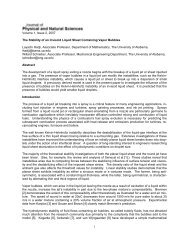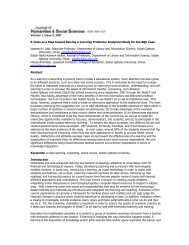The Heaven and Earth Society and the Red Turban Rebellion in ...
The Heaven and Earth Society and the Red Turban Rebellion in ...
The Heaven and Earth Society and the Red Turban Rebellion in ...
You also want an ePaper? Increase the reach of your titles
YUMPU automatically turns print PDFs into web optimized ePapers that Google loves.
failed, <strong>and</strong> much of <strong>the</strong> violence of <strong>the</strong> rebellion pitted <strong>the</strong> Punti rebel aga<strong>in</strong>st <strong>the</strong> Hakka militias. In this<br />
sense, ethnicity was central to both <strong>the</strong> recruitment success <strong>and</strong> eventual failure of <strong>the</strong> rebellion. 113<br />
Q<strong>in</strong>g Forces<br />
As far as that <strong>the</strong> <strong>in</strong>itial failure of <strong>the</strong> Q<strong>in</strong>g forces aga<strong>in</strong>st <strong>the</strong> <strong>Red</strong> <strong>Turban</strong> rebels was concerned, <strong>the</strong><br />
important factor was <strong>the</strong> failure at this po<strong>in</strong>t of <strong>the</strong> methods of rural control which <strong>the</strong> Q<strong>in</strong>g government had<br />
employed. <strong>The</strong> baojia 保 甲 was <strong>in</strong>tended to prevent <strong>the</strong> development of disorder <strong>in</strong> rural areas. 114 But to deal<br />
with more serious threats to security, <strong>the</strong> Q<strong>in</strong>g government had at its comm<strong>and</strong> a large st<strong>and</strong><strong>in</strong>g army. This<br />
was organized <strong>in</strong>to two great divisions, Banner troops <strong>and</strong> troops of <strong>the</strong> Green St<strong>and</strong>ard. Western<br />
missionary reports from <strong>the</strong> Ch<strong>in</strong>a Repository show that <strong>in</strong> Guangdong <strong>the</strong> Banner troops, nom<strong>in</strong>ally<br />
number<strong>in</strong>g about 5,000, were under <strong>the</strong> comm<strong>and</strong> of <strong>the</strong> Manchurian General <strong>and</strong> all stationed at<br />
Guangzhou. <strong>The</strong> Green St<strong>and</strong>ard troops, number<strong>in</strong>g approximately 70,000, were distributed throughout <strong>the</strong><br />
prov<strong>in</strong>ce. 115 <strong>The</strong> system of military control had rema<strong>in</strong>ed largely unchanged s<strong>in</strong>ce <strong>the</strong> Manchu conquest, <strong>and</strong><br />
<strong>the</strong> dis<strong>in</strong>cl<strong>in</strong>ation of <strong>the</strong> Manchus to place complete trust <strong>in</strong> <strong>the</strong> Green St<strong>and</strong>ard forces was displayed by <strong>the</strong><br />
practice of divid<strong>in</strong>g <strong>the</strong> army <strong>in</strong>to separate comm<strong>and</strong>s. <strong>The</strong> greater part of <strong>the</strong> forces were under <strong>the</strong><br />
prov<strong>in</strong>cial Comm<strong>and</strong>er-<strong>in</strong>-Chief ( 提 督 ), <strong>and</strong> were stationed <strong>in</strong> Huizhou. Under him also were <strong>the</strong> naval forces.<br />
But both <strong>the</strong> Governor-General <strong>and</strong> <strong>the</strong> Governor had separate forces under <strong>the</strong>ir comm<strong>and</strong>, <strong>the</strong> former<br />
largely stationed at Zhaoq<strong>in</strong>g 肇 慶 , <strong>and</strong> <strong>the</strong> latter at Guangzhou. 116 <strong>The</strong> situation was fur<strong>the</strong>r complicated by<br />
<strong>the</strong> fact that, although <strong>the</strong> military headquarters of <strong>the</strong> various comm<strong>and</strong>s were territorially separate, <strong>the</strong>re<br />
was no territorial division of military responsibility, <strong>and</strong> <strong>the</strong> forces of each comm<strong>and</strong> were distributed<br />
throughout <strong>the</strong> prov<strong>in</strong>ce.<br />
Military garrisons were distributed <strong>in</strong> most of rural areas of Guangdong; however, <strong>the</strong>re was<br />
<strong>in</strong>sufficient protection from <strong>the</strong> local officials aga<strong>in</strong>st <strong>the</strong> threat. While <strong>the</strong> magistrate had overall<br />
responsibility for <strong>the</strong> security of his district, <strong>the</strong> forces at his disposal were extremely limited. Military<br />
garrisons were not under his comm<strong>and</strong>. In order to make arrests, he could use <strong>the</strong> yamen-runner, who <strong>in</strong><br />
some ways served as a police force. But if <strong>the</strong>re were any disorder <strong>in</strong> <strong>the</strong> district, <strong>the</strong> magistrate had ei<strong>the</strong>r<br />
to f<strong>in</strong>d local aid to deal with it, or to call for assistance from outside, <strong>and</strong> lay himself open to a charge of<br />
<strong>in</strong>competence. This problem is rooted <strong>in</strong> <strong>the</strong> absence of central government structure below <strong>the</strong> county level,<br />
coupled with laws prohibit<strong>in</strong>g magistrates from serv<strong>in</strong>g <strong>in</strong> <strong>the</strong>ir home districts. Dur<strong>in</strong>g <strong>the</strong> Q<strong>in</strong>g at <strong>the</strong> village<br />
level <strong>the</strong>re were local constables, headmen, <strong>and</strong> gentry families, <strong>and</strong> even government units for purposes of<br />
taxation, but “no formal government of any sort existed below <strong>the</strong> zhou [department] <strong>and</strong> xian [county]<br />
levels.” 117 In this period, <strong>the</strong> average county population was 100,000-250,000, a number very difficult to keep<br />
under close surveillance. 118 To be sure, <strong>the</strong> district magistrate had subord<strong>in</strong>ates charged with collect<strong>in</strong>g<br />
113 <strong>The</strong> Hakkas formed a gentry-led militia similar to <strong>the</strong> militia around Guangzhou <strong>and</strong> defeated <strong>the</strong> rebel<br />
forces at <strong>the</strong> gate of X<strong>in</strong>’n<strong>in</strong>g district town that eventually stemmed <strong>the</strong> rebel tide <strong>in</strong> this area. See X<strong>in</strong>’n<strong>in</strong>g<br />
Xianzhi, 14.18b-21b.<br />
114 To prevent <strong>the</strong> development of local disorder, <strong>the</strong> Q<strong>in</strong>g had cont<strong>in</strong>ued <strong>and</strong> improved <strong>the</strong> subadm<strong>in</strong>istrative<br />
apparatus of control that had existed under <strong>the</strong> M<strong>in</strong>g. <strong>The</strong> most important of <strong>the</strong>se was <strong>the</strong><br />
baojia. For Q<strong>in</strong>g government, <strong>the</strong> baojia had two purposes. Under <strong>the</strong> system all households <strong>and</strong><br />
<strong>in</strong>dividuals were compelled to register <strong>and</strong> to be formed <strong>in</strong>to groups of households, <strong>the</strong> bao <strong>and</strong> jia. In this<br />
respect it resembled a form of census, but at <strong>the</strong> same time s<strong>in</strong>gl<strong>in</strong>g out persons responsible for carry<strong>in</strong>g out<br />
<strong>the</strong> system. Its o<strong>the</strong>r function, which was probably considered <strong>the</strong> more important, was <strong>the</strong> duty imposed on<br />
baojia heads to report <strong>the</strong> occurrence of crimes of <strong>the</strong> existence of crim<strong>in</strong>als <strong>in</strong> <strong>the</strong>ir neighborhood. See<br />
Kung-chuan Hsiao, Rural Ch<strong>in</strong>a: Imperial Control <strong>in</strong> <strong>the</strong> N<strong>in</strong>eteenth Century. (Seattle: University of<br />
Wash<strong>in</strong>gton Press, 1960), 43-83.<br />
115 <strong>The</strong> comm<strong>and</strong>er-<strong>in</strong>-chief of <strong>the</strong> l<strong>and</strong> forces was stationed at Huizhou. His troops consisted of four<br />
brigades (zhen 鎭 ), namely, Shaozhou 韶 州 , Chaozhou 潮 州 , Gaozhou <strong>and</strong> Qiongzhou 瓊 州 . Humen 虎 門 ,<br />
on <strong>the</strong> o<strong>the</strong>r h<strong>and</strong>, was <strong>the</strong> headquarters of <strong>the</strong> mar<strong>in</strong>e forces, which consisted of four squadrons, two on<br />
each side of Humen along <strong>the</strong> coast. For details on <strong>the</strong> distribution of military forces <strong>in</strong> Guangdong, See<br />
Ch<strong>in</strong>a Repository, Vol. 4 (1835-6), 284, <strong>and</strong> Vol. 20 (1851), 54, 254.<br />
116 Ibid.<br />
117 Ch’u T’ung-tsu, Local Government <strong>in</strong> Ch<strong>in</strong>a under <strong>the</strong> Ch’<strong>in</strong>g (Cambridge: Harvard University Press,<br />
1962), 1.<br />
118 Hsiao, Rural Ch<strong>in</strong>a, 5.<br />
18



